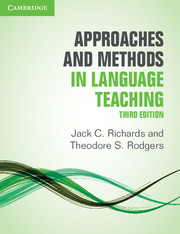Book contents
- Frontmatter
- Contents
- Acknowledgments
- Introduction to the third edition
- I Major trends in twentieth-century language teaching
- II Current approaches and methods
- III Alternative twentieth-century approaches and methods
- IV The teaching and learning environment
- Appendix: Comparison of approaches and methods
- Author index
- Subject index
1 - A brief history of early developments in language teaching
Published online by Cambridge University Press: 08 April 2022
- Frontmatter
- Contents
- Acknowledgments
- Introduction to the third edition
- I Major trends in twentieth-century language teaching
- II Current approaches and methods
- III Alternative twentieth-century approaches and methods
- IV The teaching and learning environment
- Appendix: Comparison of approaches and methods
- Author index
- Subject index
Summary
Introduction
By the beginning of the twentieth century, language teaching was emerging as an active area of educational debate and innovation. Although language teaching has a very long history, the foundations of contemporary approaches to language teaching were developed during the early part of the twentieth century, as applied linguists and others sought to develop principles and procedures for the design of teaching methods and materials, drawing on the developing fields of linguistics and psychology. This led to a succession of proposals for what were thought to be more effective and theoretically sound language teaching methods. Language teaching in the twentieth century was characterized at different times by change and innovation and by the development of competing language teaching ideologies. The impetus for change in approaches to lan-guage teaching is generally a response to increased demand for speakers of second and foreign languages. World War II, for example, prompted the need for new ways of teach-ing oral skills in foreign languages, as we discuss in Chapter 4. Large-scale movement of people through immigration as well as the internationalization of education since the 1950s also created a demand for new types of language programs. And in more recent times, globalization, the rise of the Internet, and the global spread of English has also prompted a reassessment of language teaching policies and practices. This chapter, in briefly reviewing the history of language teaching methods, provides a background for the discussion of past and present methods and suggests the issues we will refer to in analyzing these methods.
The emergence of methods
Efforts to improve the effectiveness of language teaching have often focused on changes in teaching methods. Throughout history such changes have reflected changes in the goals of language teaching, such as a move toward oral proficiency rather than reading comprehension as the goal of language study; they have also reflected changes in theo-ries of the nature of language and of language learning. The method concept in teach-ing – the notion of a systematic set of teaching practices based on a particular theory of language and language learning – is a powerful though controversial one, and the quest for better methods was a preoccupation of many teachers and applied linguists throughout the twentieth century.
- Type
- Chapter
- Information
- Approaches and Methods in Language Teaching , pp. 3 - 19Publisher: Cambridge University PressPrint publication year: 2014

